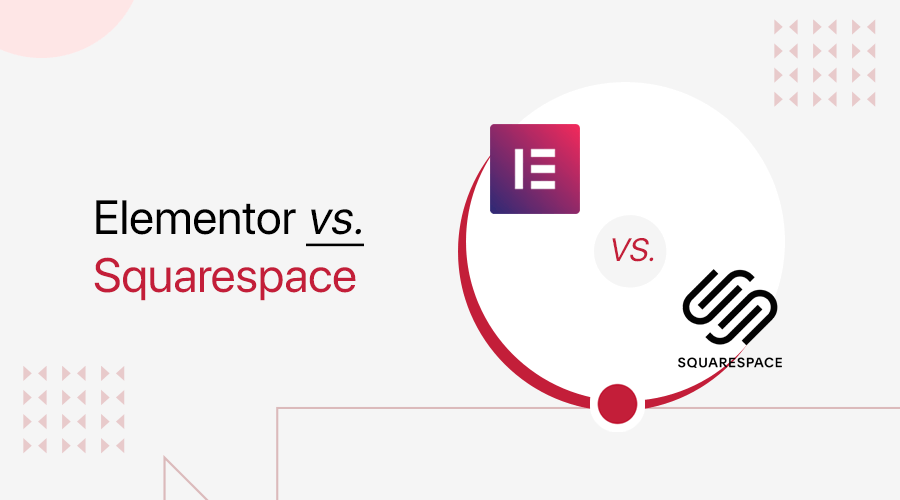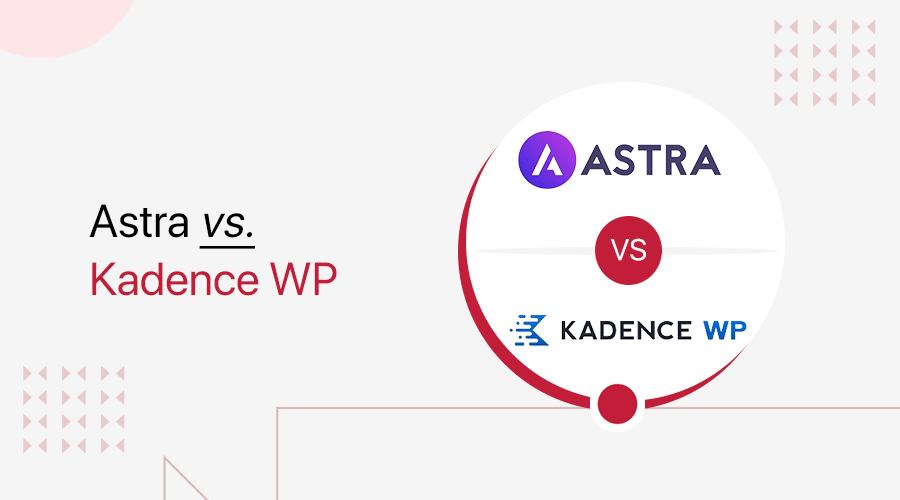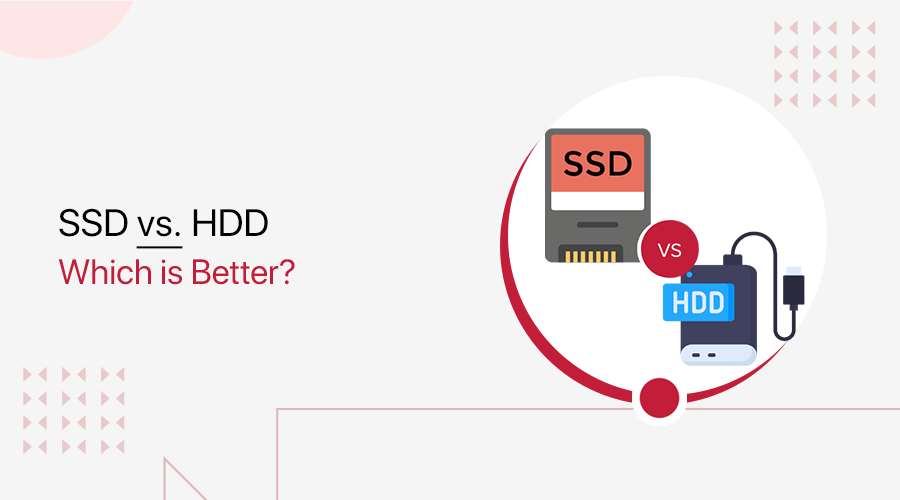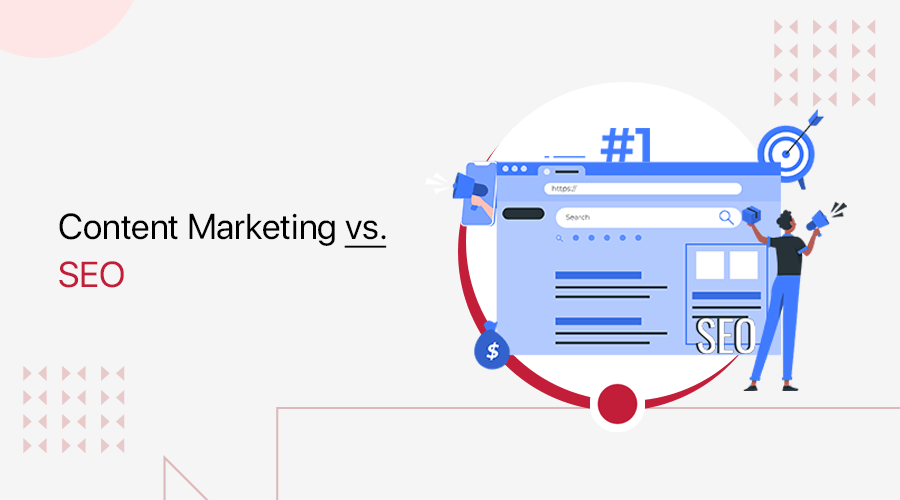
Do you need clarification about content marketing vs SEO in the world of digital marketing? If yes, then here we go!
Today’s digital world is a big puzzle, and content marketing and SEO (Search Engine Optimization) are two essential pieces. They might seem similar, but they serve different purposes in helping your business succeed online.
As digital marketing grows louder by the day, understanding this distinction is a must. It’ll guide you through the ever-changing online marketing strategies. Whether you’re a professional marketer or a newcomer, this comprehensive guide will decode the differences for you.
So, join us as we discover the mysteries of content marketing vs SEO. We’ll break things down into simple steps, so it’ll be easier for you to master them.
Now, let’s begin!
A. Understanding Content Marketing
As we know, due to digitization, information is everywhere, and people’s attention doesn’t last long. Therefore, content marketing is like a secret weapon for businesses. But first, let’s start by understanding what content marketing is and why it’s so important.
Content marketing is all about creating and sharing useful, interesting, and consistent information. Instead of trying to sell something directly, you provide content that educates, entertains, or helps your audience in some way.

Besides, it’s not just about advertising your products or services. It’s like building a friendship with your audience. You offer them valuable information, and in return, they start to trust and like your brand.
It’s a bit like planting seeds, you give useful content. And over time, you grow a group of loyal followers who appreciate what you offer.
B. Exploring Key Elements of Content Marketing
Within content marketing, there are many components that you must be aware of. Using them in your content marketing strategy can enhance your chances of attracting traffic. Consequently, you’ll meet your target audience and goal.
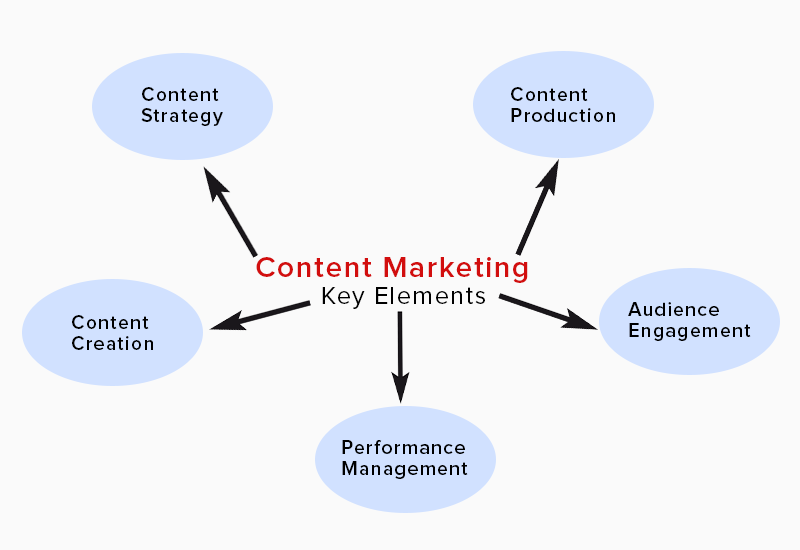
Among the various components of content marketing, we’ll explain the key 5 elements below. As we’ve come to realize, it’s a multifaceted strategy that involves several critical elements.
Let’s go through the core components that shape this art of digital engagement.
1. Content Strategy
Starting with Content Strategy, it’s a vital element of content marketing.
Simply put, content strategy stands tall as the blueprint for the success of any content marketing campaign. It serves as the map that navigates brands through the dilemma of content creation and distribution.

Let’s delve deeper into the world of content strategy and understand why it’s effective content marketing.
- Helps to create detailed buyer personas to understand your target audience’s needs and preferences.
- Define specific goals for your content, like brand awareness, lead generation, or customer loyalty.
- Develop a structured plan for content creation, including brainstorming ideas and content calendars.
- Determine how and where you’ll share your content, such as through social media, email marketing, or partnerships.
- Track content performance using metrics like engagement, conversion rates, and traffic.
- Continuously refine your content strategy based on insights to improve results over time.
2. Content Creation
Crafting valuable and engaging content is akin to painting a masterpiece. It’s not just about words on a page. It’s about creating something that resonates with your audience, sparks their interest, and compels them to take action.

Let’s delve into the art and science of content creation, one brushstroke at a time.
- Keywords are the hues on your content palette, guiding your content’s search engine visibility.
- Add variable content formats (blogs, videos, infographics, etc.) based on audience preference and your message.
- Craft headlines that intrigue and invite exploration, leaving a lasting impression.
- Create valuable content that addresses needs, offering information, education, or entertainment.
- Visuals like images and videos enhance content, making it more appealing and digestible.
- Storytelling engages readers, creating an emotional connection and memorable message.
- SEO optimization incorporates keywords naturally for a broader audience reach.
You must understand the art of content creation because it lets you create content that meets user needs. Also, it helps your site appear in relevant search results.
3. Content Production
Next is content production, it’s a vital part of any content marketing strategy. It’s the process of creating the actual content that you’ll share with your audience.
Additionally, this phase involves various steps and considerations. Simply, to ensure that the content you produce aligns with your goals and resonates with your target audience.
Here’s a closer look at what content production entails:
- Brainstorm content ideas relevant to your audience and use keyword research to find topics with high search volume.
- Outline key points and gather information for your chosen topic.
- Research thoroughly to ensure content accuracy, credibility, and support with data and examples.
- Create content in various forms (blogs, articles, videos, infographics, podcasts).
- Edit content for grammar, spelling, clarity, and coherence and optimize content for search engines.
- Pay attention to on-page SEO elements like headers, subheadings, and image tags.
- Publish on relevant platforms (website, blog, social media).
- Use analytics tools to track performance (page views, engagement, conversions).
4. Audience Engagement
Similarly, audience engagement is another key element of content marketing. It’s not just about broadcasting your message, it’s about building relationships with your audience. As well as fostering trust, and keeping them coming back for more.

So, let’s look at the strategies for effective audience engagement.
- Understand who your audience is, what they like, what problems they face, and what they’re passionate about.
- Create interactive content like quizzes, polls, surveys, and contests that invite participation.
- Share user-generated content on your platforms to showcase the authenticity of your community.
- When your audience comments, ask questions, or shares their thoughts, be sure to respond promptly.
- Address your audience by their names, and recommend products or content based on their preferences. Making them feel like you understand them.
Likewise, you can measure the effectiveness of your audience engagement efforts by tracking several metrics.
- Likes, comments, and shares on your content.
- Click-through rates (CTR) on links in your content.
- Time spent on the page by your audience reading or interacting with your content.
- Tracking conversion rates like signing up for newsletters or making a purchase.
- Collecting feedback and surveys from your audience.
5. Performance Measurement
Moving on, we have performance measurement, as it’s a critical aspect of content marketing. It’s how you gauge the effectiveness of your efforts, understand what’s working, and identify areas for improvement.
In this section, we’ll delve into the key aspects of performance measurement in content marketing.
- Setting Clear Objectives: Before you can measure performance, you need to establish clear objectives for your content marketing efforts. Your objectives serve as the foundation for measuring success.
- Key Performance Indicators (KPIs): KPIs are the specific metrics you use to track progress toward your objectives. Common KPIs in content marketing include website traffic, click-through rates, conversion rates, social media engagement, etc.
- Tools for Measurement: To effectively measure performance, you’ll need the right tools. One example can be Google Analytics, it’s a powerful tool for tracking website traffic and user behavior.
- Analyzing Data: To extract meaningful insights, you must analyze the data you’ve gathered. Look for trends, patterns, and anomalies, then identify which content pieces are resonating with your audience and which needs adjustments.
- Return on investment (ROI) Calculation: ROI is a crucial metric in content marketing. It helps you understand the financial impact of your efforts. You can compare the cost of creating and promoting content to the revenue it generates.
C. Benefits of Content Marketing
The main objectives of content marketing are to create engaging content with valuable information and to attract visitors. After going through its key elements, now we know it has importance in many other areas.
So, here’s a breakdown of the key benefits you can reap from a robust content marketing strategy:
- Engaging content improves your website’s search engine rankings, making it more discoverable to your target audience.
- Informative and engaging content attracts more visitors to your website, expanding your online reach.
- Valuable content will capture leads through forms or subscriptions, helping you grow your customer base.
- Content marketing often costs less than traditional advertising methods, delivering a high return on investment.
- Consistent, quality content reinforces your brand identity and sets you apart from competitors.
- Shareable content can extend your website’s reach through social media, increasing brand visibility.
- Consistent content can help you build a community around your brand or niche.
Hopefully, you understand content marketing, its key elements, and its benefits.
Now, let’s move ahead and learn about SEO. Ultimately, you’ll find differences between content marketing vs SEO. Here we go!
D. Exploring SEO
Search Engine Optimization, or SEO for short, is a fundamental component of the digital landscape. It’s like the map that guides you to discover your website among others.
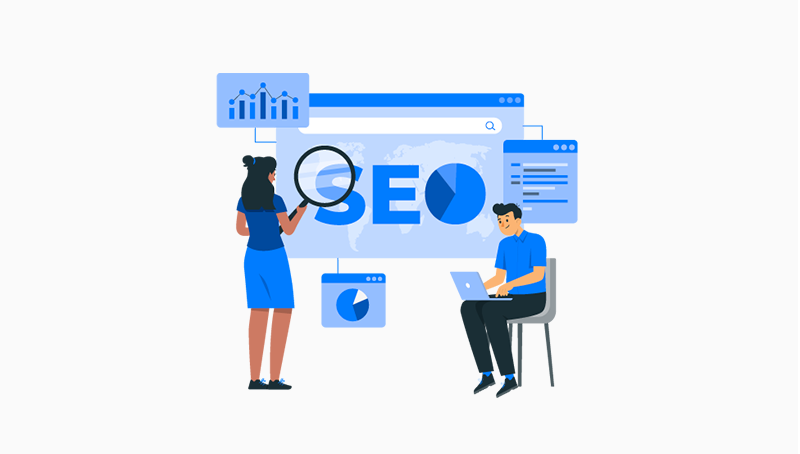
Moreover, it’s the process of optimizing your website. So that it appears higher in search engine results when people search for specific keywords or phrases.
It’s like having a treasure chest of valuable information on your site. And SEO is the key that helps others find it.
Let’s explore more in detail:
I) On-Page SEO
It involves optimizing individual web pages to rank higher in search results and earn more relevant traffic. Here’s what it includes:
- Keyword Research: Identifying the words and phrases people are using to search for information related to your content.
- Content Optimization: Crafting high-quality, informative content that incorporates those keywords naturally.
- User Experience (UX): Ensuring that your website is easy to navigate, loads quickly, and is mobile-friendly.
II) Off-Page SEO
Off-page SEO, on the other hand, focuses on factors outside your website that impact your search engine rankings. It includes:
- Backlinks: Building high-quality, authoritative links from other websites to yours.
- Social Signals: Leveraging social media platforms to promote your content and engage with your audience.
- Local SEO: Optimizing your online presence for local search is crucial for businesses with physical locations.
III) Technical SEO
Think of technical SEO as the mechanics under the hood of your website. It involves:
- Site Structure: Ensuring that your website is well-organized and easy for both users and search engines to navigate.
- Mobile Optimization: Make sure your site functions seamlessly on mobile devices.
- Page Speed: Ensuring that your pages load quickly, which is vital for user experience and SEO rankings.
- Schema Markup: Providing structured data to help search engines understand your content better.
E. Exploring Key Elements of SEO
There are tons of best practices in SEO. If you use them on your website, then it’ll help improve the overall performance on search engines.
Among those elements, here we’ll go through some of them. Now let’s explore those key elements of SEO in detail!
1. Keyword Research
Keywords are like the secret codes that help people find information on the internet. They are the words and phrases we type into search engines when we’re looking for something. They’re crucial for SEO because they connect your content with the people searching for it.

Additionally, before diving into keyword research, it’s important to know what people want when they search. Are they looking for information, trying to buy something, or solving a problem? Knowing this helps us choose the right keywords.
Besides, keyword research isn’t guesswork; it involves using special tools to find the best keywords. Tools like Google Keyword Planner and SEMrush help you discover which keywords are popular and how tough the competition is.
2. On-Page SEO and Off-Page SEO
On-Page SEO is about making your website better for visitors and search engines. It’s like tidying up your house so guests can find things easily.
Moreover, it involves strategically using relevant keywords in content, titles, and meta tags. As well as creating high-quality, user-friendly content, optimizing images, and ensuring a clean URL structure.
These efforts enhance a website’s visibility and user experience, ultimately driving more organic traffic.
Here’s how it works:
- Keywords: Use relevant keywords in our content, titles, and headings so that search engines understand what our pages are about.
- Quality Content: Create valuable, easy-to-read content that visitors find helpful.
- Meta Tags: Give your pages descriptive titles and descriptions that show up in search results.
- Images: Optimize images by using descriptive filenames and adding alt text.
- URL Structure: Also, make sure our web addresses are simple and relevant.
Whereas, Off-page SEO focuses on activities that happen outside your website. Mainly aimed at improving its online reputation and authority.
So, the key components include building high-quality backlinks from reputable sites and engaging in social media marketing. Encouraging online reviews, and collaborating with industry influencers.
These efforts collectively enhance your site’s credibility and visibility in search engine results pages.
Here’s how it works:
- Backlinks: Get other reputable websites to link to our site, showing search engines that we’re trustworthy.
- Social Media: Engage with our audience on social platforms, sharing our content and building a following.
- Online Reviews: Encourage happy customers to leave positive reviews, which can boost our credibility.
- Guest Blogging: Write articles for other websites in our industry, demonstrating our expertise.
- Influencer Marketing: Also, collaborate with influential people in our niche to reach a wider audience.
Here are some social media plugins for adding social sharing buttons to your website.
3. Technical SEO
Moving on, we’ve technical SEO, which helps to make your website perform its best in search engine rankings. By dealing with the technical aspects of your site to ensure search engines can crawl, index, and understand your content effortlessly.

Here’s what technical SEO involves:
Website Speed
- Optimize Images: Compress and reduce image sizes to enhance page loading speed.
- Minimize Code: Clean up unnecessary code and scripts to improve site performance.
- Use Content Delivery Networks (CDNs): Distribute website content across servers globally for faster delivery.
Mobile-Friendliness
- Responsive Design: Ensure your website adapts seamlessly to different screen sizes.
- Mobile Optimization: Optimize images, fonts, and layouts for mobile users.
- Mobile-Friendly Testing: Regularly check your site’s mobile-friendliness.
Indexing and Crawling
- Robots.txt: Use robots.txt to guide search engine bots on what to crawl and what to skip.
- XML Sitemaps: Create and submit XML sitemaps to search engines for efficient indexing.
- Canonical Tags: Implement canonical tags to prevent duplicate content issues.
Structured Data
- Schema Markup: Add schema markup to provide search engines with rich data about your content.
- Rich Snippets: Increase click-through rates by enabling rich snippets for your pages.
Besides these, technical SEO also involves security, site structure, accessibility, site errors, and redirects.
Find the best CDN service providers for video streaming.
4. Local SEO
When it comes to SEO, you should never forget about local SEO.
It’s like a virtual signpost that guides people to businesses in their local area. It’s all about optimizing your online presence to attract customers who are searching for products or services near them.

Moreover, it makes sure your business pops up when folks in your area search for what you offer. Also, helps to bring the right people to your door, who are more likely to become happy customers.
Plus, it’s all about trust, good reviews, and accurate info to build trust with potential customers. And the best part is, it’s a smart way to reach the right folks without breaking the bank.
Let’s look at the key elements of local SEO:
- Google My Business: Claim and optimize your Google My Business listing to appear in local searches.
- Network Access Point Consistency: Ensure your business name, address, and phone number are consistent across online directories.
- Local Keywords: Use keywords that include your city or region to help local searchers find you.
- Online Reviews: Encourage satisfied customers to leave positive reviews on platforms like Google.
If you own a WordPress website, then choose from the list of best speed optimization plugins and tools.
5. SEO Analytics and Monitoring
Just a reminder, SEO isn’t a set-and-forget task.
It requires constant surveillance and analysis to ensure your efforts are paying off. This is where SEO analytics and monitoring come into play.

SEO analytics is the process of collecting, measuring, and analyzing data related to your website’s performance in search engines. It provides valuable insights into what’s working and what needs improvement.
Having said that, let’s check out some of the key aspects of SEO analytics and monitoring.
- Track how well your chosen keywords are ranking and driving traffic to your site.
- Identify where your website visitors are coming from, whether it’s organic search, social media, or referrals.
- Understand how visitors interact with your site, including which pages they visit and how long they stay.
- Monitor the percentage of visitors who take desired actions, such as making a purchase or signing up for a newsletter.
- Measure the rate at which visitors leave your site without exploring further.
- Ensure your website loads quickly, as slow load times can impact user experience and rankings.
- Assess how well your site performs on mobile devices, as mobile optimization is crucial.
If you’re worried about how to analyze your website’s SEO, then fear not. There are many tools that you can make use of. Some of them are:
- Google Analytics: Provides a comprehensive view of website traffic and user behavior.
- Google Search Console: Offers insights into how Google sees your site, including indexing and keyword performance.
- SEO Software: Tools like SEMrush, Moz, and Ahrefs offer in-depth SEO analytics and competitor analysis.
F. Benefits of SEO
Search Engine Optimization is more than a word in digital marketing, it’s a powerhouse for online success.
And after going through its key elements, we know its significance in many other areas. In a nutshell, the following are some of the benefits of implementing technical SEO strategies:
- SEO helps your website show up in search results, making it easier for people to find you.
- Sites that rank well are often seen as more trustworthy and reliable by users.
- With improved rankings, you attract more visitors who are genuinely interested in your content.
- Compared to paid advertising, SEO can provide long-term results without hefty ad spend.
- SEO practices enhance site speed and navigation, creating a smoother experience for visitors.
- Outranking competitors means you grab a larger slice of the online market.
- With the help of local SEO, you can easily connect your businesses with nearby customers.
Always remember, SEO isn’t just about ranking higher. It’s also about transforming your online presence and reaping these remarkable benefits.
With that, you may have some idea of the difference between content marketing vs SEO. If you want a clear comparison, then keep reading!
G. What are the Differences Between Content Marketing vs SEO?
Here, let’s learn the differences between content marketing vs SEO:
1. Focus and Approach
Content marketing and SEO have distinct focuses and approaches, as outlined in the table below.
| Focus and Approach | Content Marketing | SEO |
| Primary Objective | Engaging the audience with valuable content. | Optimizing search engines to improve visibility. |
| Audience-Centric | Yes, it focuses on providing value to the audience. | Yes, but primarily concerned with search engine algorithms. |
| Content Creation | Creates content that educates, entertains, and informs. | Focuses on optimizing existing content for search engines. |
| Keywords | Uses keywords but prioritizes relevance and value. | Relies heavily on keywords for optimization. |
2. Content Creation vs Optimization
These differences highlight that both content marketing and SEO involve content creation. However, they serve distinct purposes and require different approaches to engage the audience and improve online visibility.
| Content Marketing | SEO |
| Utilizes a wide range of content types like blogs, videos, infographics, podcasts, and social media posts to engage the audience. | Primarily focuses on optimizing web page content, including text, images, and meta tags, for search engines. |
| Optimization primarily revolves around creating content that resonates with the target audience. | Optimization revolves around making web pages more visible to search engines like Google. |
| Aims to inform, entertain, educate, and engage the target audience with valuable content. | Aims to improve a webpage’s visibility in search engine results by optimizing content for specific keywords. |
| Often creates evergreen content that remains relevant and valuable over an extended period. | Requires ongoing optimization and may involve frequent updates to align with changing search engine algorithms. |
3. Key Metrics and Success Indicators
As both content marketing and SEO go hand in hand, the key metrics and success indicators are different. Let’s take a look at them.
| Content Marketing | SEO |
| The number of times your content is viewed and how long visitors spend engaging with your content. | Monitoring the positions of your web pages in search engine results pages (SERPs) for specific keywords. |
| The number of times your content is shared on social media platforms like Facebook, Twitter, and LinkedIn. | Measuring the volume of visitors who arrive at your site through non-paid (organic) search results. |
| The percentage of visitors taking desired action, like signing up for a newsletter, purchasing, or filling out a contact form. | Calculating the percentage of users who click on your search result compared to the total number of users who see it. |
Success in SEO is often indicated by improvements in these metrics over time. While success in content marketing is indicated by achieving your defined goals.
4. Timeline and Persistence
The timeline and persistence of content marketing and SEO can vary depending on your goals and strategy. Here’s a breakdown:
| Aspects of Differences | Content Marketing | SEO |
| Timeline | Short-term results like social media marketing. Long-term results like search engine rank, and medium-term results like blog posts or videos. | Keyword research, website audit, on-page and off-page optimization, monitoring performance, and algorithm updates. |
| Persistence | Consistency, evergreen content, and adaptation to changes. | SEO is not a one-time project; it’s an ongoing effort to maintain and improve a website’s visibility in search results. |
5. Collaboration and Integration
Collaboration and integration play vital roles in the success of content marketing and SEO efforts.
Here’s how they work together:
| Content Marketing | SEO |
| -Involves various professionals, including writers, designers, videographers, and editors. – Collaboration with the brand team ensures consistency in tone, style, and values across all content. – Working together with marketing and social media teams, data analysts, and audience through comments, surveys, and feedback. – Align with sales and customer support teams to ensure that content addresses common customer queries. | – Collaborate closely with content creators for optimized content. – Content teams and SEO specialists work together to incorporate relevant keywords naturally into content. – Works with web developers to implement on-page SEO. – Integrate data from analytics tools to measure the impact of SEO efforts accurately. – SEO aligns with content distribution strategies to reach the right audiences. |
Collaboration and integration in content marketing involve working closely with various teams and departments to create and promote content. Whereas, SEO involves working closely with various teams, integrating data, and aligning goals.
And if you want to build a WordPress website, then check out our article on how to create a website.
So, that’s all for our content marketing vs SEO guide.
Frequently Asked Questions FAQs on Content Marketing vs SEO
Last but not least, we’re here for some FAQs. Below you can read out loud to solve basic confusion regarding content marketing vs SEO.
1. How do content marketing and SEO contribute to a digital marketing strategy?
Content marketing, with its engaging and informative content, draws in your target audience. SEO ensures that this content is easily discoverable by ranking it higher in search results.
2. Can content marketing and SEO be used together?
Absolutely! Content marketing provides substance like blogs, videos, and articles that captivate your audience. Whereas, SEO provides the structure, the optimization that helps your content shine in search results. Together, they elevate your digital marketing strategy.
3. Which strategy, content marketing or SEO, is more effective for increasing website traffic?
It’s not a matter of one being better than the other; it’s about harmony. Content marketing draws in your audience with valuable content. While SEO ensures this content gets noticed. Alone, they’re good, but together, they’re unstoppable.
4. How do content marketing and SEO impact brand visibility and recognition?
Content marketing helps to craft the spotlight-worthy content, and SEO ensures it’s on the center stage of search engine results. Together, they increase your brand’s visibility, making it shine brightly and leaving a lasting impression on your audience.
5. Are there any ethical considerations when it comes to SEO and content marketing?
Yes, ethical SEO and content marketing mean playing by the rules. No shortcuts, no black-hat tactics. It’s about providing genuine value to your audience, being transparent, and respecting their privacy. As ethical practices build trust also lead to long-term success.
Conclusion
And that’s all! We’re at the final part of this content marketing vs SEO guide. Hopefully, you understand the differences between content marketing and SEO.
In a nutshell, both content marketing and SEO are the backbone of any website. Content marketing engages audiences. While SEO ensures it’s discoverable. Both have some similar elements, while some are different.
If you’re still confused about content marketing vs seo, then place your queries in the comment. We’ll try to provide answers to your questions.
In addition, please read our articles on the best AI content writing tools and affiliate marketing.
Also, share our blogs you like with your friends, colleagues, and family.
Last but not least, follow us on Facebook and Twitter to find the latest articles.
